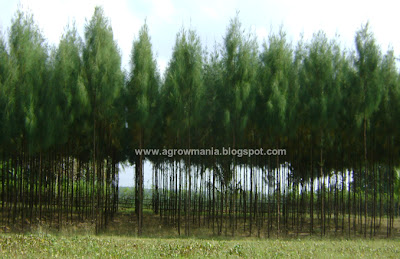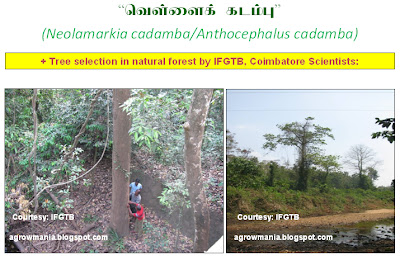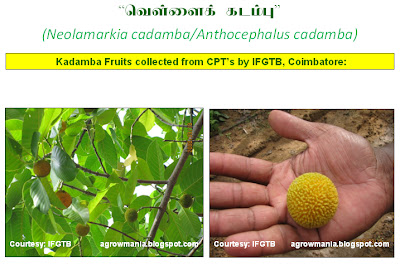Casuarina junghuhniana for sustainable energy development:
Some snippets from IFGTB 'Tree Growers Mela -2012:
Part - 6
Casuarina junghuhniana for sustainable energy development:
A detailed report on 'Casuarina junghuhniana for sustainable energy development' is the joint work of Mr.S.K.Shanmuga sundaram, IFS, Present Chief Conservator of Forests, Tirunelveli (Former Head of the Department of Biodiversity, IFGTB) and Dr.R.Gopalan and presented as Power point by the former professionally to the audience, who are mostly farmers, on the concluding day of the Tree growers Mela - 2012.
This report analyzes in detail the issues involved in "Energy management, Growth Vs Energy, Types of energy, Energy Resources, Energy efficiency, Current Energy Demand, Energy consumption, Energy scenario in India and Biomass power".
This report analyzes in detail the issues involved in "Energy management, Growth Vs Energy, Types of energy, Energy Resources, Energy efficiency, Current Energy Demand, Energy consumption, Energy scenario in India and Biomass power".
From the above presentation, I would like to bring to our readers the main subject of 'Utilizing Casuarina for Biomass power production' only.
This report is generated from the PowerPoint
presentation of Mr.S.K.Shanmuga Sundaram,IFS and the contents in its entirety and the projections / assessment made here are his personal views
only.
Those readers who may differ on the issues of yield, profit from Casuarina junghuhniana, matters relating to energy conversion and the quantum of power production are requested to express their views here to upgrade this article for the benefit of the fellow readers.
CASUARINA – A BIO RESOURCE :
- A tree species belonging to Casuarinacea.
- Fast growing species, having multi utility value.
- Calorific value = 5000 k.cal. (Approx.)
- Wood density is 698 kg/m³ (irrigated), 703 kg/m³ (rainfed).
- Preferred by farmers for Agro forestry and Farm land afforestation.
CURRENT UTILITY OF CASUARINA :
- HOUSEHOLD FUEL, PULP WOOD,
- SCAFFOLDING, CHARCOAL MAKING,
- BIO SHIELD (SHELTER BELT, WIND BREAK)
- PRODUCTION OF POWER
EXTENT OF CULTIVATION :
- Casuarina is cultivated through out South India.
- 80% of plantations are in the coastal areas in AP, Orissa, Tamil Nadu and Pondicherry.
- Area planted – 5 lac ha. Inland cultivation data deficient.
- Rotation 4 years.
- Inter cropping practiced in Ist year of planting.
- Preferable species Casuarina junghuhniana, a drought tolerant and high yielding variety.
- Espacement 1x1m (4000 trees per acre).
YIELDING PATTERN :
—Yield varies by
1. Locations
2. cultivation techniques adopted
3. Period of rotation
4. Irrigation facilities
5. Fertilizer application
6. Soil fertility
7. Rainfall pattern
8. 40 to 80 tonnes per acre in 4 years and 30 to 40 tonnes per acre under rainfed conditions is reported.
ECONOMICS OF CASUARINA CULTIVATION :
Usage of high yield clones, 4 year rotation, 1x1m espacement, Coastal
belt, Irrigated land, yearly farm yard manure application, yearly twice
weeding and manual pruning of branches gives the following revenue:
Total income (sale of pruned materials & poles) = 2,50,000 /-* (Average yield 80 Tons x Rs.3000 + 10000)
Total expenditure (including watch and ward) = 75,000 /-
Net Income = 1,75,000 /-
* Data for high yielding variety with the specified field conditions.
CASUARINA vs ELECTRICITY:
CALORIFIC VALUE = 5000 Kcalories
One kilowatt per hour = 859.845kilo calories.
Energy conversion efficiency of casuarina = o.25.
The power production by using One ton of casuarina =
5000x1000x1/4x/859.845 = 1453.75 kwh
—
5MW Power Mill (Plant Load Factor=0.9)
Per day production =1000X5X24X0.9 =108000kwh
Per year production =108000x365 =39420000kwh
Casuarina wood required per year
=39420000/1453.75=27116.07911m.ton.
Per day requirement =74.29 rounded to75m.tons.
Area required@productivity of 60m.tons per acre
with 4 year rotation period =452acres
For continuous operation =452x4=1808acres
Per day area required =1.23acres(0.5ha)
—
Total no. of blocks in Tamil nadu=397
Area required for cutivation of casuarina for operation of
5M.W.power mill in all the blocks=397x1808=717776 acres
5M.W.power mill in all the blocks=397x1808=717776 acres
Power production capacity=397x5=1985mw.
BIOMASS POWER PLANTS:
VIABILITY OF POWER PLANTS:
—Cost
of electricity per unit=4.65
—Revenue
to be realized per year=39420000x4.65= Rs 183303000
—Cost
of wood =27116x3000= 81348000
—Profit
margin=183303000-81348000=Rs 101955000
—Viability
is facilitated by many other factors.
INCENTIVES TO THE MILLS:
2. Fiscal incentives in terms of excise duty concession, reduced
customs duty.
3. 80% accelerated depreciation for IT purpose in I year of
installation.
4. Tax holidays for 10 years for profit from the project.
5. Power purchase @Rs4.65/unit as per tariff order of TNERC.
6. Concessional wheeling charges of 3% for distance upto 25 km and
6% for distance beyond 25 km for captive use.
ADDITIONAL BENEFITS TO THE MILLS:
- Bio char.
- Activated charcoaL
- CDM.
- Prevent migration.
- Additional employment.
- Land improvement.
- Theft, Prevention of transmission loss.
- Protection of environment.
SCOPE FOR MAXIMISING ELECTRICITY PRODUCTION:
- BLOCK
WAR POWER MILL IN TAMIL NADU.
- REDUCTION IN TRANSPORTATION COST.
—TRANSMISSION
LOSS REDUCED.
—PARTICIPATION
BY LOCAL COMMUNITY.
—COST
EFFECTIVE PRODUCTION.
—BETTER
LAND USE STRATEGY.
—ENABLES
ENERGY SECURITY OF THE BLOCK.
—ENSURES
GREEN AND CLEAN ENERGY.
—ADDITIONAL
REVENUE TO FARMING COMMUNITY.
STRATEGY TO BE ADOPTED:
1. START PRODUCER COMPANIES IN EACH BLOCK.
2. ALL FARMERS AND CONSUMERS ARE TO BE MADE AS
-MEMBERS,WITH SHARE PARTICIPATION.
3. GOVT. IS ALSO A MEMBER WITH MAXIMUM SHARE
VALUE OF
RS.25-CRORES.
4. ROLE TO BE ASSIGNED TO BLOCK LEVEL TREE GROWERS.
5. EFFORTS TO MAKE IT AS A ‘CDM ‘ PROJECT.
6. TIE UP WITH TREE GROWERS TO PROCURE WOOD
SIMILAR TO
-CANE PROCUREMENT BY SUGAR
MILLS.
7. VENTURE CAPITAL FOR ERECTION AND RAISE PLANTATIONS
8. CAUTION FOR DIVERSION OF LAND FROM AGRICULTURE AT THE
-COST OF FOOD
SECURITY.
9. SUBSIDY AND SOFT LOAN ARRANGEMENT THROUGH NEW
AND
-RENEWABLE ENERGY DEPARTMENT.
BENEFITS TO MEMBERS (Farmers):
1.Members (read as farmers) will initially receive only such value for the
produce or products pooled and supplied as the directors may determine.
2. The withheld amount may be disbursed later either in cash or in kind
or by allotment of equity shares.
3. Members will be eligible to receive bonus shares and patronage bonus
(akin to dividend).
(Concluded).
Some points to discuss:
1. Readers are requested to send their opinion and corrections required in
the given report to my email.
2. Clarifications regarding some contentious issues like yield and profit from
Casuarina junghuhniana and matters relating to energy conversion and power
production will be sent to the above authors on your behalf and their replies
will be published in this blog.
Regards,
A.Vishnu Sankar.
A.Vishnu Sankar.


























